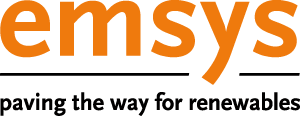50Hertz launches redispatch with renewable energy with support from emsys VPP
New processes for renewable energy suppliers connected directly to the 50Hertz transmission system have been fully implemented
Things are moving forward: on 1 November, 50Hertz implemented the financial settlement for the redispatching of renewable generating units which are directly connected to the 50Hertz grid, called Redispatch 2.0. The official processes of the Federal Network Agency were applied for this settlement. 50Hertz focused on four offshore and 60 onshore wind farms with a total installed capacity of around 2.5 GW. The electricity they generate is currently being directly marketed by 20 companies. In 2020, these renewable generating units, which are directly connected to the transmission system, were responsible for 15% of the total feed-in management measures across the 50Hertz control area.
According to Dr Dirk Biermann, Chief Markets and System Operations Officer at 50Hertz, the launch of Redispatch 2.0 marks an important step: "In a new energy world that will no longer be characterised by major power plants, but rather by volatile renewable energy and decentralised power generation, the new redispatching regime is urgently needed to involve these units in congestion management. In the years to come, we will be preparing for the continued massive and rapid growth in renewable energy and the coal phase-out. To that end, we require new processes. Our motto is to deliver this with our partners as soon as possible!"
The launch on 1 November was preceded by extensive and successful tests which were undertaken with emsys VPP, a software service provider, and several direct marketers. These tests comprised all relevant process steps, including the provision of input data, the exchange of activation documents and full accounting, the control of wind farms and the publication of measures on www.50hertz.com. By the end of February 2022, Redispatch 2.0 should also be fully implemented for all units at the distribution system level. That is why the launch on 1 November was such an important step: it will contribute to ensuring that other units can be securely integrated into the process.
Dr Ulrich Focken, Director of emsys VPP GmbH from Oldenburg, commented: "We and many others in the energy sector have worked hard on the implementation of the new Redispatch 2.0 processes over the past months. We are very pleased to have made the step towards full implementation with 50Hertz. This finally gives renewable energy more system responsibility."
Sven Nels, Managing Director of BayWa r.e. Energy Trading GmbH, adds: "The introduction of the new processes means that, for the first time, interventions by a grid operator in our portfolio will be balanced by the grid operator itself. This practically completes the transition of balancing responsibility from the direct marketer to the grid operator as intended by the legislation. This is the first milestone towards a full implementation of the new Redispatch 2.0."
Background information:
Until now, the redispatching system only used conventional power plants to reduce grid bottlenecks: the power plant output was reduced in front of the capacity bottleneck and increased behind it. If this did not suffice to solve the bottleneck, renewable generating units were curtailed in a separate process (feed-in management). In the case of feed-in management, the direct marketing company took care of the financial settlement on the market. Under Redispatch 2.0, system operators are obliged to handle the financial settlement of their measures. The advantage of this is that they can already take into account grid-supporting criteria. The launch was originally planned for 1 October 2021, but was postponed across almost all grid areas through the application of the transitional solution of the German Association of Energy and Water Industries BDEW (Bundesverband der Energie- und Wasserwirtschaft). As a result, all system operators involved have until late February 2022 to implement the financial settlement of Redispatch 2.0, and will do so in coordination with the direct marketing companies which are active in their grid areas. 50Hertz has now taken the first step with the units which are directly connected to its transmission grid and has fully implemented the Redispatch 2.0 process.
The Redispatch 2.0 process was launched in order to reduce the costs for congestion management and integrate today's feed-in management into the redispatching process. In the scope of the Grid Expansion Acceleration Act (Netzausbaubeschleunigungsgesetz or NABEG), Redispatch 2.0 opens up new possibilities to use system-supporting services and flexibilities from different grid levels. This requires closer cooperation between distribution and transmission system operators as well as highly complex technical solutions for data exchange and unit control. The connected process is a huge challenge for the entire energy industry. Redispatch 2.0 means that even the operators of very small generating units with a minimum electrical output of 100 kW (such as rooftop solar panels belonging to commercial companies or combined heat and power plants) can always make their units available for redispatching measures within a short amount of time, thus contributing to ensuring system security. The system management departments of the transmission system operators manage and coordinate these measures. The goal of Redispatch 2.0 is to establish a fully automated process in which transmission system operators can use these small units to support the system. On the one hand, this means that cooperation across several grid levels is automatically coordinated; on the other hand, data from generators and all grid levels must be recorded and processed collectively.

